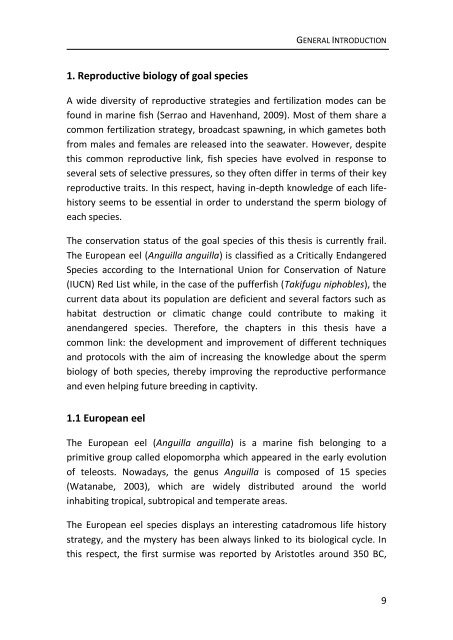chapter 3 - RiuNet
chapter 3 - RiuNet
chapter 3 - RiuNet
Create successful ePaper yourself
Turn your PDF publications into a flip-book with our unique Google optimized e-Paper software.
GENERAL INTRODUCTION<br />
1. Reproductive biology of goal species<br />
A wide diversity of reproductive strategies and fertilization modes can be<br />
found in marine fish (Serrao and Havenhand, 2009). Most of them share a<br />
common fertilization strategy, broadcast spawning, in which gametes both<br />
from males and females are released into the seawater. However, despite<br />
this common reproductive link, fish species have evolved in response to<br />
several sets of selective pressures, so they often differ in terms of their key<br />
reproductive traits. In this respect, having in-depth knowledge of each lifehistory<br />
seems to be essential in order to understand the sperm biology of<br />
each species.<br />
The conservation status of the goal species of this thesis is currently frail.<br />
The European eel (Anguilla anguilla) is classified as a Critically Endangered<br />
Species according to the International Union for Conservation of Nature<br />
(IUCN) Red List while, in the case of the pufferfish (Takifugu niphobles), the<br />
current data about its population are deficient and several factors such as<br />
habitat destruction or climatic change could contribute to making it<br />
anendangered species. Therefore, the <strong>chapter</strong>s in this thesis have a<br />
common link: the development and improvement of different techniques<br />
and protocols with the aim of increasing the knowledge about the sperm<br />
biology of both species, thereby improving the reproductive performance<br />
and even helping future breeding in captivity.<br />
1.1 European eel<br />
The European eel (Anguilla anguilla) is a marine fish belonging to a<br />
primitive group called elopomorpha which appeared in the early evolution<br />
of teleosts. Nowadays, the genus Anguilla is composed of 15 species<br />
(Watanabe, 2003), which are widely distributed around the world<br />
inhabiting tropical, subtropical and temperate areas.<br />
The European eel species displays an interesting catadromous life history<br />
strategy, and the mystery has been always linked to its biological cycle. In<br />
this respect, the first surmise was reported by Aristotles around 350 BC,<br />
9
















